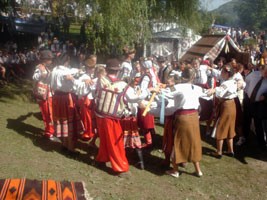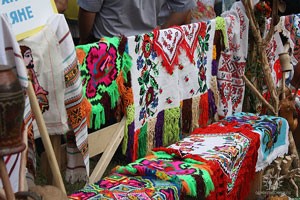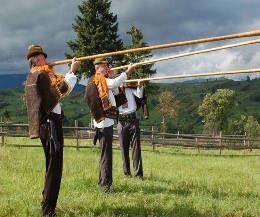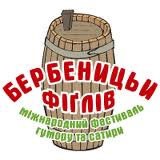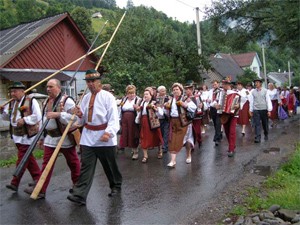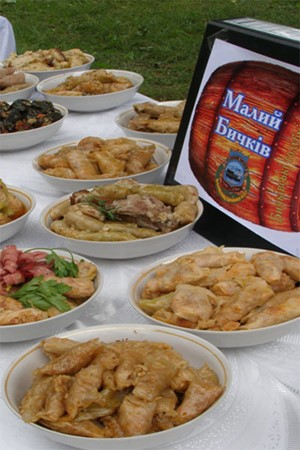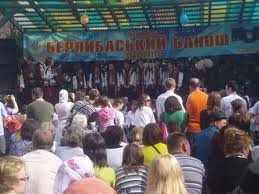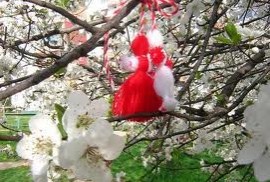Tour Description
Tourists that travel to the Carpathians, can not only admire picturesque mountains, covered with evergreen woods, beautiful ancient buildings, but also get acquainted with national traditions and trades, which are best preserved in the form of festivals.
Taking part in a festival gives tourists an opportunity to learn many interesting things about the life of the local people, take a closer look at the authentic culture and customs of Ukrainians, taste local food, which is traditional to a particular village or region.
The tourist product is developed for 3 days in the form of a weekend tour, which begins on Friday in Ivano-Frankivsk, but can be diversified in its duration, and the number of tourist objects, which precede the festivals. As a rule, all the festivals take place at weekends: Saturday and Sunday. There is also a basic 3-day tour, which includes observation excursions to the most interesting tourist objects of Ivano-Frankivsk Oblast, as well as the transportation to the places, where festivals are held (no more than 70km).
Another advantage of this tourist product is in the comfortable transportation of tourists back to the starting point after the ending of the tour.
The route of the tour:
Ivano-Frankivsk − Yaremche − Tatariv − Yablunytsia − Lazeshchyna − Yasinia – Rakhiv.

Tour "Festival kaleidoscope"
|
Tour Programme |
|
Day 1. Ivano-Frankivsk − Yaremche − Tatariv |
|
Meeting tourists at the railway station in Ivano-Frankivsk. Observation tour “Ivano-Frankivsk through 4 centuries”. The town of Ivano-Frankivsk was founded in 1662. It is situated between the rivers of Bystrytsia Nadvirnianska and Bystrytsia Solotvynska. Its former name was Stanislaviv. Town-fortress was built in a short period of time (5 months) by Francois Korassini of Avignon (France) in the form of a regular hexagon with additional bastions, redoubts and a fort. The fortress was built according to the state-of-the-art fortification science. The town bagan at the Market Square and the Town Hall, which preserved in an altered state until our days. Connoisseurs of sacral tourism will be attracted by one of the oldest buildings of the city ‒ renaissance Parochial Church, built in 1703, which was once a chapel and a burial vault of the Pototsky family. Today it contains Prykarpattia Arts Museum. To the left of the museum, there is a rotunda with a fountain and the monument of the Virgin Mary. Behind it – the building of the former Jesuit Church (1763), and now – Holy Resurrection Cathedral UGCC. Not far from it, there is the Armenian Church (1762), now − Saint-Pokrovsky Temple of Ukrainian Autocephalous Church. Another interesting place for the guests and citizens of Ivano-Frankivsk may be the Local Museum, situated in the Town Hall. Today it contains more than 105 000 exhibits. Observation bus tour “From the town of Stanislav to the town of Yarema” along the route Ivano-Frankivsk – Yaremche. An excursion to the Church of St. Ilya the Prophet in the village of Dora. The church was built at the beginning of the 20th century and belongs to monastery Studite Brethren. The town of Yaremche is a tourist capital of Ivano-Frankivsk Oblast, located in a picturesque lowland between the mountains along the river Prut. In 1787, Yaremche was first mentioned as a town. The town began to develop after the construction of the railroad Stanislav – Yaremche – Vorokhta – Rakhiv in 1894. The railroad runs through the mountains with numerous stone bridges and tunnels, and is a monument of the art of engineering. Starting from the 19th century, Yaremche develops as a resort town, visited by people from Kraków, Lviv, Vienna and other European cities. The territory of the town belongs to balneological resorts of Ukraine with beautiful wooden landscapes and clear mountain air. Yaremche is situated in the central part of the Carpathian Mountains, including a part of Horhany, Pokytsko-Bukovynski Carpathians and Chornohory. The main river is Prut, which has its source at the north hills of Hoverla at 1750m above sea level. There is also a couple of sources of mineral water (“Naftusia” and “Myrhorodska”). There are also unique monuments of wooden architecture: the Church of the Nativity of Virgin Mary (17thcentury) in Vorokhta, the Church of the Holy Trinity (1868) in Mykulychyn, Church of St. Ilya the Prophet (1930) in Dora. The territory of Yaremche belongs to Carpathian National Park. Dinner in a traditional Hutsul kolyba in Yaremche. A tour through the town of Yaramche visiting Probij Waterfall, souvenir shops, and the visitor-centre of CNNP. Probij Waterfall with the height of 8m. It is a picturesque corner of nature on the river Prut with the cascade of waterfalls. From a 20m high bridge, one can watch how Prut falls into a narrow stone bowl, created by nature. Dovbush Stone. The accumulation of boulders creates interesting forms with terraces and caves. It was named in honour of national hero Oleksa Dovbush, who was a leader of the opryshky movement. Ecotourism visitor centre in Yaremche. The visitor-centre presents an exposition of natural exhibits and cultural artefacts of the Carpathian Region. There is also a souvenir shop, an electronic information kiosk, as well as a room equipped to hold conferences and show films. Carpathian National Nature Park (area: 50.3 ha). The aim of the park is to preserve natural mountain and river complexes, valuable historical, architecture and ethnographic monuments. (www.cnnp.yaremcha.com.ua, www.carpathians.org.ua) Moving to Yaremche – Tatariv. The village of Tatariv is a mountain resort situated at 750m above sea level. Local climate helps to cure lung diseases. In the 18th century, Tatariv was first mentioned as a village. Owing to the unique microclimate, the village is considered to be a health resort. A lot of people visited Tatariv to cure asthma or allergic diseases. It is located not far from Bukovel ski resort (12km), which attracts many tourists in the wintertime. Settling in the private farmstead “Anastasia” and “Fainyi” cottage. TIC Tatariv, farmstead “Anastasia” www.tatariv.info. Tourists are provided with comfortable rooms in the cottage, 2-3 meals a day. For additional payment: access to the Internet, laundry, nurse services, sauna, massage. Transportation services (a car), including transportation to the railway station and ski lifts. Tourists also have an opportunity to climb the highest mountains of the Carpathians, take trips to mountain lakes, and visit museums. “Fainyi” cottage, mini-hotel “Prutets” http://prutets.karpaty.info. A modern two-storey cottage with 6 rooms (for 12 people). Fpr additional payment: laundry and ironing service: individual use of kitchen. Sauna, ski equipment rentals, quad bike rentals are situated near the cottage. Tourists also have an opportunity to visit Vorokhta, Yaremche, Kolomyia, Kosiv, Rakhiv, Maniava Skete, Solotvyno salt lakes, Mt. Hoverla and other places. They can also take a trip to the mountains, and gather mushrooms and berries. The nearest ski trails with ski lifts are situated in Yablunytsia, Vorokhta and Bukovel ski resort (Polianytsia Village). Traditional Hutsul supper with the degustation of local drinks and liqueur in the front room of farmstead “Anastasia”. Drymba master classes and photo shoots in the national costumes. |
|
Day 2. Tatariv – Rakhiv – Tatariv |
|
Breakfast. Moving to Tatariv ‒ Rakhiv. Taking part in the festival “Hutsul Brynza” (Rakhiv). Festival The festival is a calling card of Rakhiv Region. It has been demonstrating the best achievements and traditions of Hutsul Region for more than 10 years already. Festival-fair «Hutsul Brynza» was established in 1999. This feast annually celebrates the rebirth and development of cattle breeding, sheep breeding in particular. That’s why today sheep breeding is not only one of the traditional spheres of agriculture, but also a component of original history, ethnography and culture of Rakhiv Region. From time immemorial polonynska vatra has protected shepherds and their flocks. Polonynska vatra is also an integral part of «Hutsul Brynza» festival. After the bonfire is lit, visitors have an opportunity to see numerous exhibitions. The festival ends with festivities. According to the data provided by the festival organizers, almost 10 000 people visit «Hutsul Brynza». |
|
Day 3. Tatariv – Rakhiv – Tatariv – Ivano-Frankivsk |
|
Taking part in the second day of the festival. Returning to Ivano-Frankivsk making a stop in Kvasy or Mykulychyn. A walking tour to Zhenetskyi Waterfall (Huk) (3 km of distance). The waterfall is situated at 900 m above sea level. It was formed in post-war years as a result of a flood. The water falls from the height of about 15 m. It got such a name because of the noise. Arrival at Ivano-Frankivsk railway station. The ending of the tour programme. Departure of the participants of the tour. |
The list of 8 main festivals in Rakhiv Region, Zakarpattia Oblast, which are chosen for making festival tours
|
Name of the festival |
Description |
|
«Hutsul Brynza» (Rakhiv) |
The festival is a calling card of Rakhiv Region. It has been demonstrating the best achievements and traditions of Hutsul Region for more than 10 years already. Festival-fair «Hutsul Brynza» was established in 1999. This feast annually celebrates the rebirth and development of cattle breeding, sheep breeding in particular. That’s why today sheep breeding is not only one of the traditional spheres of agriculture, but also a component of original history, ethnography and culture of Rakhiv Region. From time immemorial polonynska vatra has protected shepherds and their flocks. Polonynska vatra is also an integral part of «Hutsul Brynza» festival. After the bonfire is lit, visitors have an opportunity to see numerous exhibitions. The festival ends with festivities. According to the data provided by the festival organizers, almost 10 000 people visit «Hutsul Brynza». |
|
«Kvasivskyi Lizhnyk » (Kvasy)
|
Lizhnyk is a blanket made of sheep wool with the ornament, peculiar to certain Hutsul Region. The aim of the festival-fair “Kvasivskyi Lizhnyk” is to preserve not only the art of making woollen blankets, but also other local traditions and customs, as well as to demonstrate the ability of our people to manage household, their skills of embroidery, cooking, singing, dancing. The festival is also aimed at preserving and passing on original traditions, developing rural tourism, launching new projects for the development of infrastructure of the village. |
|
«Hutsul Ripa» (Lazeshchyna, the 1st Sunday of September)
|
Ripa is a local name of potato. Most of the events of the festivel take place in Urochyshche Klyva. There one can buy different goods: from clothes to foods, as well as taste homemade dishes and other delicacies. During the festival one can taste grated, boiled, fried, stewed and baked potato, ripiani halushky (small boiled dumplings), varenyky with brynza, deruny (potato pancakes), ripianyky, ripa with brynza, varenyky with ripa. Apart from tasty cuisine, one can enjoy beautiful nature, visit concerts and take part in different competitions. |
|
International Festival of Humour and Satire "Berbenytsia Figliv" (Yasinia, July)
|
Berbenytsia figliv (a barrel of jokes) is the international festival of humour and satire held annually in the middle of July in Yasinia (on the Day of the Village). The main theme of the festival is Hutsul people making jokes about their life in the mountains. The festival lasts for two days, during which professional and amateur jokers from Ukraine, Romania and Hungary entertain the audience with authentic national folklore. Poems, anecdotes, humoresques and plays. The festival also includes presentation of excursion programmes, fair of handicraft goods, competition of national clothing and the best vyshyvanka. There is also a parade, when berbenytsia (the barrel) is carried on britzka accompanied by troisti muzyky, participants and spectators. |
|
"Vydrychanska Vyshyvanka" (Vydrychka, July)
|
Vyshyvanka (a shirt decorated with embroidered insets of different colours) is one of the main articles of Hutsul clothing. Embroidered ornaments on vyshyvankas are different in every village of Rakhiv Region. The festival is meant to show the richness of embroidery of Hutsul clothes, explain the symbolism of ornaments and give fresh impetus to inherit the ethnic and national peculiarities in designing modern clothes. The festival also includes displays of different kinds of embroidery: vyshyvanka embroidered with threads; vyshyvanka embroidered with beads; embroidered tablecloth; embroidered rushnyk; Hutsul souvenir. Performances of Hutsul dance and song groups, different competitions and festivities are an indispensable part of the festival. |
|
«Bychkivski holubtsi» (Velykyi Bychkiv, August)
|
Festival «Bychkivski holubtsi» celebrates the Day of the Village. In 2010 a record number of holubtsi (25 kinds) was cooked in Zakarpattia. The festival is held at a high level. The festival programme includes performances modern bands and folk groups from different corners of Hutsul Region. The festival is preceded by solemnities, sports competitions and festivities. |
|
Berlybash banosh (Kostylivka, May)
|
Berlybashka is a historic name of Kostylivka Village and a name of a mountain valley where local people herd their cattle. Banosh is an ethnic Hutsul dish, cooked by the shepherds on the mountain valleys. The ingredients of the dish are sour cream and maize flour. Banosh is the calling card of this festival. Local people also cook delicious holubtsi, varenyky, deruny (potato pancakes), homemade sausage, bryndza and many other dishes of Hutsul cuisine. They also herbal liquors. Performances of local dance and song groups, festivities and other entertainments are an integral part of the festival. |
|
«Martisor» (Bila Tserkva)
|
Feast «Martisor» is a traditional holiday that celebrates the beginning of spring and dates back to 1989. Apart from preserving Romanian customs, traditional ceremony, songs and dances, this holiday promotes cultural and economic relations with Romanian ethnic groups that inhabit different countries of the world. On this day one can watch performances of Romanian folklore dance groups, both local and foreign ones; cook and taste national Romanian foods; go to a gala concert. |
Table of transportation part of the tour “Festival kaleidoscope”
(The timing is given taking into consideration the condition of the roads for the transportation with excursion vehicles)
|
№ |
Route |
Distance |
Duration |
|
1 |
Ivano-Frankivsk − Yaremche |
65 |
1.30 |
|
2 |
Vorokhta − Tatariv |
8,3 |
0,15 |
|
3 |
Tatariv − Yablunytsia |
9,3 |
0,15 |
|
4 |
Tatariv − Lazeshchyna |
18,6 |
0,30 |
|
5 |
Lazeshchyna − Yasinia |
3,7 |
0,10 |
|
6 |
Yasinia − Rakhiv |
31,1 |
1,00 |
|
7 |
Rakhiv − Dilove |
18,6 |
0.30 |
|
8 |
Dilove – Serednie Vodiane |
29,4 |
0.45 |
|
9 |
Serednie Vodiane − Solotvyno |
12,3 |
0.30 |
|
10 |
Serednie Vodiane − Khust |
55 |
1.30 |
|
11 |
Solotvyno − Khust |
55,7 |
1.30 |
|
12 |
Serednie Vodiane − Rakhiv |
48 |
1.15 |
|
13 |
Solotvyno – Baia Mare |
169 |
4-6 |
|
14 |
Yaremche − Ivano-Frankivsk |
65 |
1.30 |
|
15 |
Yaremche − Maniava |
49,8 |
1 |
|
16 |
Maniava − Dolyna |
66,5 |
1.30 |
|
17 |
Maniava − Ivano-Frankivsk |
44,0 |
1 |






